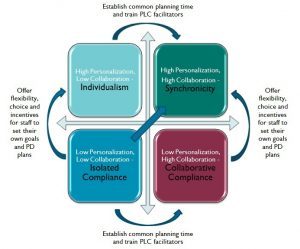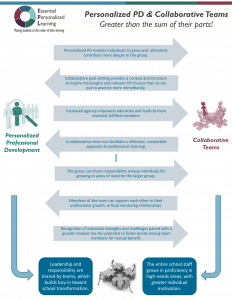Personalized PD and Collaborative Teams: A Symbiotic Approach to Professional Learning, Part 1
CompetencyWorks Blog

This post originally appeared at the Center for Collaborative Education on September 5, 2017.
Those of us who consider ourselves progressive and who regularly coach schools tend to focus our support on either collaboration or personalization. Schools that worry about the isolation of the traditional teacher, and teachers who yearn to share ideas, tend to focus on establishing Professional Learning Communities (PLCs), also known as Critical Friends Groups (CFGs). These groups become the mechanism of choice for propagating best practices, distributing leadership, and building collective buy-in for school reform or redesign initiatives. On the other hand, schools that fear teacher disengagement or who weary of professional development that never gains traction with teachers to foster improved student results tend to experiment with the newer approach, personalized professional development. This offshoot of personalized learning provides a structured way for teachers to share—or own—decision-making about the professional development with which they will engage, granted that it aligns with the school’s overall goals and the district’s other logistical parameters.
Both practices have promise individually, and because both represent a significant shift away from typical “sit and get” district- or school-wide professional development (PD), school leaders tend to invest their reform efforts around one or the other. After all, both approaches are ambitious and require capacity building, effective systems, and buy-in, which require time and effort. Both can result in improved teacher empowerment and even save districts money. However, unless these reforms are strategically bundled in tandem, I would argue that neither can meet its full potential to open up, and dramatically improve, classroom practice.
I have seen schools that institute PLCs begin to encounter a dreaded implementation gap when teachers mistrust (sometimes with good reason) the intention of the initiative, viewing the PLCs as a top-down, forced experience, or an attempt to further standardize practice to the detriment of teachers’ individual agency. At times, there are situations in which the PLCs are an overt means of prescribing professional development, in which principals mask top-down mandates under the guise of collaborative teamwork: arguably, these instances are poor or inauthentic implementation of PLCs. However, there are also many instances in which PLCs themselves are created with the authentic intention to build a safe community in which teachers can de-privatize practice, but the PLCs do not meet their potential to be revolutionary because they occur in isolation, providing a single outlet for teacher voice in a school that otherwise silences it.
Similarly, otherwise traditionally-structured schools that make a foray into the realm of personalized professional learning find a number of logistical hurdles that can hamper implementation. While personalized professional development plans and teacher micro-credentials, two means of personalizing PD, can provide incentives and structures that will inspire and guide teachers to learn, neither is a panacea. When poorly instituted—or done in isolation—these innovations can overly rely on educators’ knowledge of their own skills and their inevitably limited awareness of the opportunities for PD available to them. Schools may include data analysis, self-assessments and selected catalogues to mitigate some of these problems—or principals may build learning plans in tandem with their staff—but these can still result in ad hoc, sporadic instances of professional learning that may not align with the school’s overall goals or plans.
However, the implementation challenges that hamper both PLCs and personalized PD tend to resolve when the two are implemented together—or treated as two independent phases of a larger initiative. The increased agency that personalized PD instills will empower the members of the PLCs to see their involvement as opportunities to share—rather than receive—learning. Likewise, the collective work of the PLC can serve to inspire its members to set goals and pursue micro-credentials or PD experiences to complement the collective learning. Individuals are more motivated to grow in proficiency in high-needs areas that will benefit the larger community. Simultaneously, leadership and responsibility is shared by teams, which builds buy-in toward school transformation. This synchronicity is represented on the following infographic:

Of course, simultaneous implementation of both PLCs and personalized PD involves an intentional and strategic approach. In an upcoming follow-up post, I’ll share some guidance that schools can use when attempting to bring these two, approaches into practice. But before this can happen, it’s important to recognize the myriad ways in which the two approaches are mutually beneficial:

Both collaborative teams like PLCs and personalized PD approaches bear great promise when implemented well, but when implemented together—as represented here—we begin to see their truly transformative power. In this way, educators and their schools build a delicate double helix of growth, transforming their school for the benefit of all its members, staff and students alike.
See also:
- What I Learned at CompetencyWorks’s National Summit: Let’s End the Tradeoff Between Accountability and Teacher Professionalism
- The Teacher Association Perspective on Performance-Based Learning
- Training Teachers for Competency-Based Learning Classrooms
Diana Lebeaux (Senior Associate, Personalized Learning Network) works at CCE to develop dynamic professional development, coach and support schools through the school change and design process, and grow a robust and successful Personalized Learning Network.